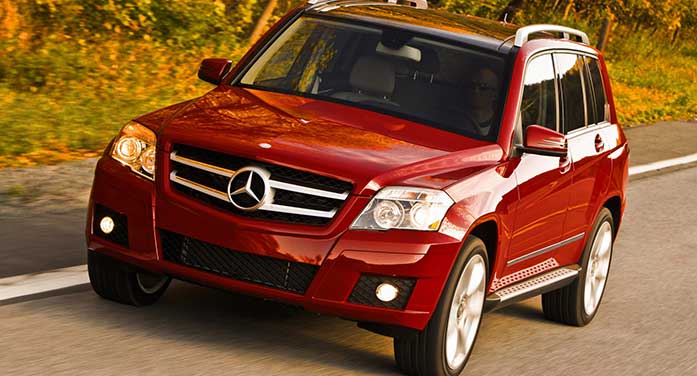
The GLK 350 is an upscale compact luxury SUV with modern conveniences galore and an extensive list of standard equipment
 The compact Mercedes-Benz GLK 350 was introduced in 2010 and designed with younger customers in mind.
The compact Mercedes-Benz GLK 350 was introduced in 2010 and designed with younger customers in mind.
According to the company, the SUV was aimed at brand-conscious young professionals with an active lifestyle, plus up-and-coming female buyers. There are few, if any, differences between the 2010 and 2011 models.
It featured a 3.5-litre V6 engine that developed 268 horsepower, mated to a seven-speed automatic transmission with a manual shift feature.
Fuel economy was decent but not exceptional – 13.3 litres per 100 km in town and 9.6 on the highway – and the GLK 350 offered lively but not overwhelming performance.
Four-wheel drive was standard issue and featured Mercedes’ tried and true 4Matic “slip and grip” setup. Onboard monitors sense wheel slippage and/or loss of traction, simultaneously reducing power to the wheel(s) in question, and redirecting torque to another corner where the power will do the most good. The Mercedes-Benz GLK 350 was the fourth generation of Mercedes’ 4Matic, used throughout the model range.
Despite its four-wheel-drive system, the GLK 350 is primarily an upscale compact luxury SUV, with modern conveniences galore and an extensive list of standard equipment. Heated front seats, power tilt/telescoping steering, cruise control, climate control system and Bluetooth connectivity all are standard.
You could also order features like a rear-view camera, media interface with iPod, USB, backseat DVD entertainment system and a navigation system. You could choose between genuine leather upholstery or Mercedes’ faux leather fabric Artico.
The GLK 350 was also equipped with a conventional floor shift instead of the push-button column shifter found on some Mercedes models.
Although it featured a comparatively choppy ride, the GLK 350 was a typical Mercedes behind the wheel. Comfort level was high – in the front seat area – and you could choose between 19-inch or 20-inch wheels and tires.
It also came with Mercedes’ new Agility Control suspension setup, which automatically adjusts the suspension to suit driving conditions. For around-town cruising and off-road situations, it eases up on the damping and gives a less harsh ride with more suspension travel than during high-speed conditions. If the driver executes tight cornering and abrupt turning manoeuvres, the system tightens up to cope.
 Other features that came with the GLK 350 include split-folding rear seats, 1,549 litres of storage space with all the seats folded flat, a full complement of safety equipment, including four-wheel disc anti-locking brakes, front side and side curtain airbags, and a unique emergency braking system that automatically increases brake pressure during a panic.
Other features that came with the GLK 350 include split-folding rear seats, 1,549 litres of storage space with all the seats folded flat, a full complement of safety equipment, including four-wheel disc anti-locking brakes, front side and side curtain airbags, and a unique emergency braking system that automatically increases brake pressure during a panic.
No safety recalls are on file for the 2011 GLK 350, but the U.S. National Highway Traffic Safety Administration (NHTSA) has 45 technical service bulletins for the 2010-11 models. These covered a lot of ground, including recalcitrant front seatbelts, issues with the alloy wheels, software and hardware glitches, a power rear lift gate that may not close properly and possible leakage from the power steering pump hose assembly.
Despite receiving top marks in virtually every category, this vintage of the GLK 350 only garnered an “average” used car prediction from Consumer Reports. Skimpy rear passenger legroom and counter-intuitive controls and switchgear seemed to be issues with CR.
Comments to CR from owners included:
- “doesn’t have that ‘Made In Germany’ quality that I thought it would”;
- “feels more like a V8 than a V6”;
- “overly wide step-over required for entry”;
- “would love more cargo room.”
Complaints about the lack of rear passenger elbow room and mediocre fuel economy are fairly common here.
Depending on the level of equipment, you can expect to pay somewhere from $15,000 to $18,000 for a 2011 GLK 350. Although there were several packages (Sport and Premium) with various extras, there was essentially only one model.
2011 Mercedes GLK 350
Original base price: $41,300
Engine: 3.5 litre V6
Horsepower: 268
Torque: 235 foot pounds
Transmission: seven-speed automatic
Fuel economy (litres/100 km): 13.3 city and 9.6 highway, with regular fuel
Drive: four-wheel
Alternatives: Honda CR-V, BMW X3, Infiniti FX35, Audi Q5, Toyota RAV4, Hyundai Santa Fe, Kia Sorento, Suzuki XL-7, Subaru Forester, Ford Escape, Mitsubishi Outlander, Nissan Xterra
Ted Laturnus has been an automotive journalist since 1976. He was named Canadian Automobile Journalist of the Year twice and is past president of the Automobile Journalists Association of Canada (AJAC). For interview requests, click here.
The views, opinions and positions expressed by columnists and contributors are the authors’ alone. They do not inherently or expressly reflect the views, opinions and/or positions of our publication.
© Troy Media
Troy Media is an editorial content provider to media outlets and its own hosted community news outlets across Canada.

